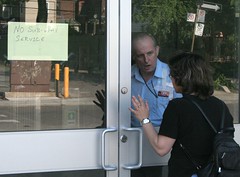Back then, the province of Ontario made big sweeping announcements, including it's boldest promise -- to have a one-fare system across several regional transit authorities, so that you could ride public transit from Mississauga in the west, all the way to Pickering in the east, and only pay one fare.
That never happened, nor did most of those big sweeping plans.
Over fifteen years later, despite numerous plans since, nothing has been done to move the now over five million people around, and gridlock is a nightmare most of our waking lives.
Today, the province re-instated it’s funding for the latest massive public transit plan – Transit City. In a letter to the city, they promised all four light rail lines would go ahead, however the letter has no mention of how the province will accomplish this, failing to provide a breakdown of funding for the 10-years of the plan.
It is so typically predictable that politicians hand out mega sums of money for massive projects just prior to an election, only to somehow forget their promises once re-elected, that people have become cynical, jaded and frustrated with the constant on-again-off-again promises.
If politicians want to really win re-elections, maybe they should stop making promises they have absolutely no intentions of fulfilling – for one – and actually living up to the promises they do make prior to an election – for two.
That’s it, it isn’t rocket science. You don’t have to spend a million dollars on some third-party consultancy composed of recent MBA graduates to conduct a study about how to win back public support and trust – just do what you said you would.
Sheesh.
Worse part about the constant on-again-off-again planning of our lying politicians – because that IS what they are – is by putting off good sound planning, our cities, towns and villages – the places we eat, sleep, live, work and play – continue to erode.
Regardless of whether you drive a big honkin’ gas guzzling four-by-four SUV, or take public transit, by not funding mass public transit plans, you – and everyone else – suffers.
Without a proper public transit system in place, growing in step with the growth of the city, town or village where you live, that means everyone will drive. And that means when you hop in your car to go to work, so will everyone else. And that means you’ll have to either constantly arrive late for work, or leave early, just to sit in traffic, so that everyone can get to work. Going home later will be the same mess, just a different direction – and you always want to get home faster than you do to work.
By continuing to fail to live up to their public transit plans, our politicians also show us their true environmental face – and it is anything but green.
Obviously, if the politicians use the environment to get elected, they know it matters to most of us. But by quickly using the funding they promised for environmental initiatives – like public transit – for other uses, it shows they themselves really don’t care about the environment.
Guess lying to their constituents – like you – just comes natural for our donut dunking drones in political office?
Who’s willing to bet that the Transit City plan for Toronto will suddenly disappear AFTER the next provincial election?
Put my name on that list -- I like easy money.
![Reblog this post [with Zemanta]](http://img.zemanta.com/reblog_e.png?x-id=2365916c-2701-497c-ac56-2efcfa4fb4b1)
![Reblog this post [with Zemanta]](http://img.zemanta.com/reblog_e.png?x-id=b3d9ab5a-907d-49ad-b142-ca6aacb02f47)
![Reblog this post [with Zemanta]](http://img.zemanta.com/reblog_e.png?x-id=52a743ba-570d-4d17-8458-b9801bd769b7)
![Reblog this post [with Zemanta]](http://img.zemanta.com/reblog_b.png?x-id=7e74e9ab-7ae7-483d-a489-4d79d02544ec)

![Reblog this post [with Zemanta]](http://img.zemanta.com/reblog_b.png?x-id=7efbbb4d-6943-41ca-a70a-c40f1e344afe)
![Reblog this post [with Zemanta]](http://img.zemanta.com/reblog_b.png?x-id=6e29c60e-c3ea-4f2e-bd92-f12476d6152d)
![Reblog this post [with Zemanta]](http://img.zemanta.com/reblog_b.png?x-id=d4c19ce8-59bb-41a5-b19a-be18b688b09b)



![Reblog this post [with Zemanta]](http://img.zemanta.com/reblog_b.png?x-id=0973f356-0d6f-45fc-9594-6164e68bac43)



![Reblog this post [with Zemanta]](http://img.zemanta.com/reblog_b.png?x-id=cf9fdb69-6eb7-4505-a4d7-c93117c11a84)







